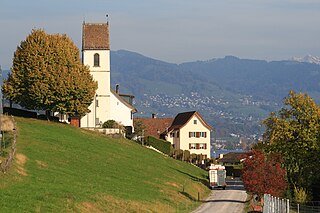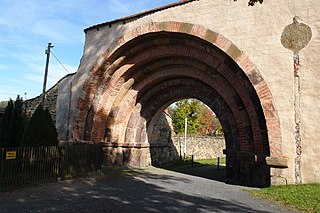
Lusatia is a historical region in Central Europe, split between Germany and Poland. Lusatia stretches from the Bóbr and Kwisa rivers in the east to the Pulsnitz and Black Elster rivers in the west, and is located within the German states of Saxony and Brandenburg as well as in the Polish voivodeships of Lower Silesia and Lubusz. Lusatia's central rivers are the Spree and the Lusatian Neisse, which constitutes the border between Germany and Poland since 1945. The Lusatian Mountains, separate Lusatia from Bohemia in the south. Lusatia is traditionally divided into Upper Lusatia and Lower Lusatia.

Bischofswerda is a small town in Germany at the western edge of Upper Lusatia in Saxony.

Upper Lusatia is a historical region in Germany and Poland. Along with Lower Lusatia to the north, it makes up the region of Lusatia, named after the Slavic Lusici tribe. Both parts of Lusatia are home to the West Slavic minority group of the Sorbs.

Bogatynia is a town in Zgorzelec County, Lower Silesian Voivodeship, in south-western Poland.

Dobrilugk Abbey was a Cistercian monastery in Lower Lusatia in the territory of the present town of Doberlug-Kirchhain, Brandenburg, Germany.

Baindt Abbey, otherwise the Imperial Abbey of Baindt, was a Cistercian nunnery in Baindt in the district of Ravensburg in Baden-Württemberg, Germany.

Ostritz is a town in the district Görlitz, in the Free State of Saxony, Germany. It is situated on the border with Poland, on the left bank of the Lusatian Neisse, 16 km south of Görlitz.

The Diocese of Dresden–Meissen is a diocese of Catholic Church in Germany with its seat in Dresden. It is suffragan to the Archdiocese of Berlin.
The Evangelical Church Berlin-Brandenburg-Silesian Upper Lusatia is a United Protestant church body in the German states of Brandenburg, Berlin and a part of Saxony.

Medingen Abbey or Medingen Convent is a former Cistercian nunnery. Today it is a residence for women of the Protestant Lutheran faith near the Lower Saxon town of Bad Bevensen and is supervised by the Monastic Chamber of Hanover. The current director of the abbey (Äbtissin) is the art historian Dr Kristin Püttmann.

Bollingen is a village (Kirchdorf) within the Swiss municipality of Rapperswil-Jona in the canton of St. Gallen.

Altzella Abbey, also Altzelle Abbey, is a former Cistercian monastery near Nossen in Saxony, Germany. The former abbey contains the tombs of the Wettin margraves of Meissen from 1190 to 1381.

Sonnefeld Abbey is a former Cistercian nunnery in Sonnefeld in Bavaria, Germany. The former abbey church, or Klosterkirche, is now an Evangelical Lutheran parish church.

Eastern Upper Lusatia is a natural region in Saxony and, in a broader sense, part of the Western Sudetes range including the Lower Silesian Voivodeship. The current Saxon division of natural regions view the region as part of the Saxon Loess Fields and divides it into 12 subdivisions at the level of meso-geochores.

Günterstal Abbey, earlier also Güntersthal Abbey, was a Cistercian nunnery that existed from 1221 to 1806 located in Günterstal, which today is a district in Freiburg im Breisgau, Germany.

Otto Carl Alfred Moschkau (1848-1912) was a German philatelist and local historian. In 2021 he was retrospectively named as one of the fathers of philately.

Nothgottes is a Cistercian monastery and a pilgrimage destination above Eibingen, in Rüdesheim am Rhein, Hesse, Germany. Pilgrimages to the location date back to the 14th century, and have continued to the present day, especially an annual pilgrimage from Kruft that began in 1674.

















